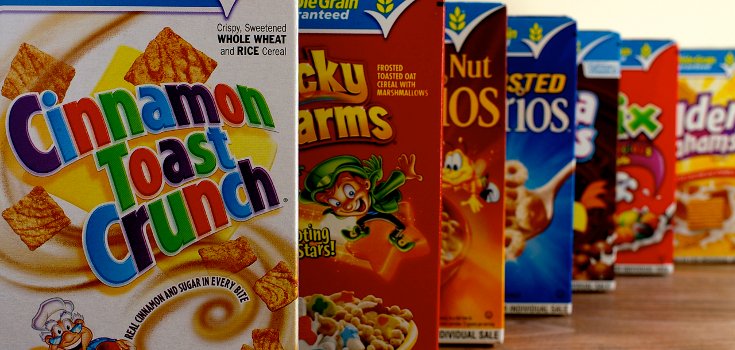The 37 Cereals Loaded With Disease-Linked Mega Sugar

A favorite meal among children of all ages, cereal has become a primary focus for food producers to push on children through sly marketing and advertising. Unfortunately, Tucan Sam and Tony the Tiger don’t represent anything that children should be eating. In fact, a new report has found that many popular cereals contain alarming amounts of sugar – even as much as 8 or even 10 teaspoons. Worse, the amount of sugar used has often increased over the past 2 years, despite promises from food makers to reduce sugar content.
(The report covers cereals in the UK, but the same or similar cereals can be found in the US under similar names.)
According to research by the campaign group Action On Sugar, 14 out of 50 cereals were full of at least a third sugar – 33.3g per 100g, or eight teaspoons in each serving. Action On Sugar nutritionist Kawther Hashem said: “You wouldn’t give your child chocolate biscuits for breakfast, yet certain manufacturers are effectively doing that for us.”
Among the worst offenders was Aldi’s Harvest Mrm Choco Rice, where a single bowl contained 39g sugar/100g – almost half of the 25g maximum daily intake of free sugars for adults in the UK.
The highest sugar cereals include:
- Aldi’s Harvest Morn Choco Rice with 39g/100g. (An 18% increase since 2012)
- Kellogg’s Frosties with 37g/100g. (Same as 2012)
- Sainsbury’s Honey Nut Corn Flakes with 36.3g/100g. (An 8% increase since 2012)
- Kellogg’s Crunchy Nut with 35g/100g. (Same since 2012)

Thankfully, some cereal-producers notice that we are in a health movement, and have lowered their sugars content. Aldi’s Harvest Morn Crunchy Honey Nut Corn Flakes made a 19% reduction from 34.4g to 28.0g/100g and Honey Monster Puffs (previously Sugar Puffs) reduces sugar by 17% from 35.0g to 29.0g/100g.
Graham MacGregor, chairman of Action On Sugar and professor of cardiovascular medicine at Queen Mary University of London, said:
“Children quickly become used to high-sugar cereals and find healthier ones less palatable, which has long-term implications on their health. Too much sugar leads to weight gain, raising the risk of type 2 diabetes, heart disease and some cancers. One of the greatest failures in tackling obesity is the Government’s appeasement of the food industry.
The Responsibility Deal, which allows the food industry to regulate themselves – likened to Dracula being put in control of the blood bank – has failed. It’s time for it to be scrapped.“

In response to the report, some cereal-producers gave comments:
- Kellogg’s said the sugar in its cereals was to a tiny proportion of daily consumption.
- Sainsbury’s said it had not increased the sugar in Honey Nut Corn Flakes, but had recalculated, which had led to a higher figure.
- Morrisons said its Honey & Nut Corn Flakes had not changed and could not explain the increase. From next month it will have 8 per cent less sugar.
- Aldi also said it would reduce the sugar content of its cereals.
Interestingly, the cereals with the highest sugar content have not responded to the calls for less sugar, and have either increased or stayed the same since 2012. I suppose these makers want less spotlight as they will continue to load cereal products with teaspoons of sugar.

Needless to say, we face similar issues here in the US. The Environmental Working Group released its own report a few years ago. Here is what the report found:
- Kellogg’s Honey Smacks – 55.6%
- Post Golden Crisp – 51.9%
- Kellogg’s Froot Loops Marshmallow – 48.3%
- Quaker Oats Cap’n Crunch OOPS! All Berries – 46.9%
- Quaker Oats Cap’n Crunch original – 44.4%
- Quaker Oats Oh!s – 44.4%
- Hellogg’s Smorz – 43.3%
- Kellogg’s Apple Jacks – 42.9%
- Quaker Oats Cap’n Cunch’s Crunch Berries – 42.3%
- Kellogg’s Froot Loops original – 41.4%
The World Health Organization has changed its sugar recommendation—advising no more than 5 percent of your daily calories should come from the sweet stuff, down from the previously recommended 10 percent. Maybe it’s time to throw the cereals to the curb.
